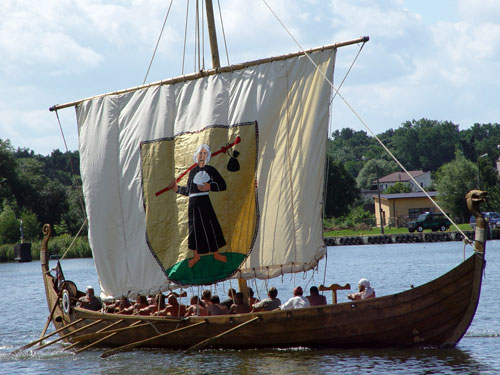|
Beitass
A beitass, or a stretching pole, is a wooden spar used on Viking ships that was fitted into a pocket at the lower corner of the sail A sail is a tensile structure—which is made from fabric or other membrane materials—that uses wind power to propel sailing craft, including sailing ships, sailboats, windsurfers, ice boats, and even sail-powered land vehicles. Sails may .... This innovation was used to stiffen and hold the edge of the sail when sailing close to the wind. References {{Sailing ship elements Sailboat components Sailing ship components ... [...More Info...] [...Related Items...] OR: [Wikipedia] [Google] [Baidu] |
Spar (sailing)
A spar is a pole of wood, metal or lightweight materials such as carbon fibre used in the rigging of a sailing vessel to carry or support its sail. These include yards, booms, and masts, which serve both to deploy sail and resist compressive and bending forces, as well as the bowsprit and spinnaker pole. In larger vessels during the age of sail, spare spars could be roped together to provide a temporary surface known as a "spar deck". These served as jury-rigged repairs for permanent decks, or as an additional platform under which to shelter goods or crew. The term was also informally applied to areas of the forecastle or quarterdeck where spare spars were stored by laying them flat against the existing decking. In the modern era the term has been used to describe the uppermost deck on flush deck Flush deck is a term in naval architecture. It can refer to any deck of a ship which is continuous from stem to stern. History The flush deck design originated with rice ships built ... [...More Info...] [...Related Items...] OR: [Wikipedia] [Google] [Baidu] |
Viking Ship
Viking ships were marine vessels of unique structure, used in Scandinavia from the Viking Age throughout the Middle Ages. The boat-types were quite varied, depending on what the ship was intended for, but they were generally characterized as being slender and flexible boats, with symmetrical ends with true keel. They were clinker built, which is the overlapping of planks riveted together. Some might have had a dragon's head or other circular object protruding from the bow and stern for design, although this is only inferred from historical sources. Viking ships were used both for military purposes and for long-distance trade, exploration and colonization. In the literature, Viking ships are usually seen divided into two broad categories: merchant ships and warships, the latter resembling narrow "war canoes" with less load capacity, but higher speed. However, these categories are overlapping; some transport ships would also form part of war fleets. As a rule, ship lanes in Scandi ... [...More Info...] [...Related Items...] OR: [Wikipedia] [Google] [Baidu] |
Sail
A sail is a tensile structure—which is made from fabric or other membrane materials—that uses wind power to propel sailing craft, including sailing ships, sailboats, windsurfers, ice boats, and even sail-powered land vehicles. Sails may be made from a combination of woven materials—including canvas or polyester cloth, laminated membranes or bonded filaments—usually in a three- or four-sided shape. A sail provides propulsive force via a combination of lift and drag, depending on its angle of attack—its angle with respect to the apparent wind. Apparent wind is the air velocity experienced on the moving craft and is the combined effect of the true wind velocity with the velocity of the sailing craft. Angle of attack is often constrained by the sailing craft's orientation to the wind or point of sail. On points of sail where it is possible to align the leading edge of the sail with the apparent wind, the sail may act as an airfoil, generating propulsive force as air p ... [...More Info...] [...Related Items...] OR: [Wikipedia] [Google] [Baidu] |
Sailboat Components
A sailboat or sailing boat is a boat propelled partly or entirely by sails and is smaller than a sailing ship. Distinctions in what constitutes a sailing boat and ship vary by region and maritime culture. Types Although sailboat terminology has varied across history, many terms have specific meanings in the context of modern yachting. A great number of sailboat-types may be distinguished by size, hull configuration, keel type, purpose, number and configuration of masts, and sail plan. Popular monohull designs include: Cutter The cutter is similar to a sloop with a single mast and mainsail, but generally carries the mast further aft to allow for a jib and staysail to be attached to the head stay and inner forestay, respectively. Once a common racing configuration, today it gives versatility to cruising boats, especially in allowing a small staysail to be flown from the inner stay in high winds. Catboat A catboat has a single mast mounted far forward and does not carr ... [...More Info...] [...Related Items...] OR: [Wikipedia] [Google] [Baidu] |


